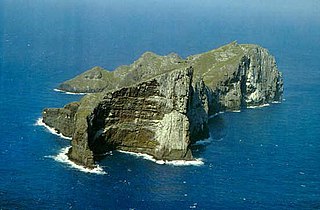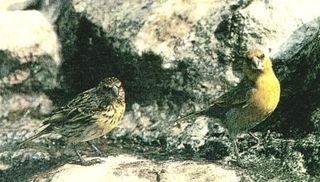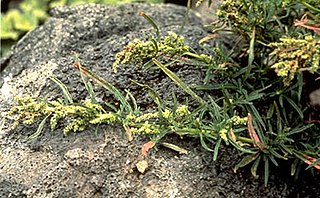
Necker Island, in Hawaiian Mokumanamana, is a small island in the Northwestern Hawaiian Islands. It is located at 23°34′30″N164°42′01″W in the Pacific Ocean, 430 miles northwest of Honolulu, Hawaii, 155 miles northwest of Nihoa, and 8 miles north of the Tropic of Cancer. It is part of the State of Hawaii in the United States. It contains important prehistoric archaeological sites of the Hawaiian culture and is part of the Hawaiian Islands National Wildlife Refuge within the Papahānaumokuākea Marine National Monument.

Nihoa, also known as Bird Island or Moku Manu, is the tallest of ten islands and atolls in the uninhabited Northwestern Hawaiian Islands (NWHI). The island is located at the southern end of the NWHI chain, 296 km (160 nmi) southeast of Necker Island. Nihoa is the closest NWHI in proximity to the eight main windward Hawaiian Islands at approximately 240 km (130 nmi) northwest of the island of Kauaʻi. The island has two peaks, 272 m (892 ft) Miller's Peak in the west, and 259 m (850 ft) Tanager Peak in the east. Nihoa's area is about 171 acres (0.69 km2) and is surrounded by a 142,000-acre (57,000 ha) coral reef. Its jagged outline gives the island its name, Nīhoa, which is Hawaiian for "tooth".

The Northwestern Hawaiian Islands or Leeward Hawaiian Islands are a series of islands and atolls in the Hawaiian island chain located northwest of the islands of Kauai and Niihau. Politically, they are all part of Honolulu County in the U.S. state of Hawaii, except Midway Atoll, which is a territory distinct from the State of Hawaii, and grouped as one of the United States Minor Outlying Islands. The United States Census Bureau defines this area, except Midway, as Census Tract 114.98 of Honolulu County. Its total land area is 3.1075 square miles (8.048 km2). All the islands except Nihoa are north of the Tropic of Cancer, making them the only islands in Hawaii that lie outside the tropics.

NatureServe, Inc. is a non-profit organization based in Arlington County, Virginia, US, that provides proprietary wildlife conservation-related data, tools, and services to private and government clients, partner organizations, and the public. NatureServe reports being "headquartered in Arlington, Virginia, with regional offices in four U.S. locations and in Canada." In calendar year 2011 they reported having 86 employees, 6 volunteers, and 15 independent officers.

The Nihoa millerbird is a subspecies of the millerbird. It gets its name from its preferred food, the Miller moth. The 5-inch (13 cm) long millerbird has dark, sepia-colored feathers, white belly, and dark beak. Its natural geographic range is limited to the tiny island of Nihoa in the Northwestern Hawaiian Islands, and it is hoped that birds translocated to Laysan will help to ensure the survival of the species. The Nihoa millerbird is one of the two endemic birds remaining on Nihoa, the other being the Nihoa finch.

The Nihoa finch is one of the two endemic bird species of the tiny Hawaiian island Nihoa, the other being the Nihoa millerbird. When it was classified in 1917, scientists thought that it would be the last endemic species named. This was later found untrue. The island's population is 1000–3000 birds. The Nihoa finch was added to the Endangered Species List by the U.S. Fish and Wildlife Service on March 11, 1967. An attempt to protect the species against extinction was made by starting a colony on French Frigate Shoals, another leeward island. This would ensure its continued existence in case the Nihoa population was wiped out. This attempt, however, failed. Nihoa is part of a group of islands that make up the Hawaiian Islands National Wildlife Refuge which provides protected land for the Nihoa finch to roam on.

Pritchardia remota, the Nihoa pritchardia, Nihoa fan palm, or Loulu, is a species of palm endemic on the island of Nihoa, Hawaiʻi, and later transplanted to the island of Laysan. It is a smaller tree than most other species of Pritchardia, typically reaching only 4–5 metres (13–16 ft) tall and with a trunk diameter of 15 centimetres (5.9 in). It is the only type of tree on the island and used to be abundant. In 1885 a wildfire ravaged the island, destroying most of the palms. Only about 700 of these trees remain, making the species endangered but numbers are slowly increasing. The palm is being cultivated in botanical gardens.

The millerbird is a species of Old World warbler in the family Acrocephalidae endemic to the Hawaiian Islands.

Amaranthus brownii was an annual herb in the family Amaranthaceae. The plant was found only on the small island of Nihoa in the Northwestern Hawaiian Islands, growing on rocky outcrops at altitudes of 120–215 m (394–705 ft). It was one of nine species of Amaranthus in the Hawaiian Islands, as well as the only endemic Hawaiian species of the genus. It is now considered extinct.
The Nihoa conehead katydid is a species of katydid which is endemic to the Hawaiian island of Nihoa. It is one of the ten species in the genus Banza, all of them native to Hawaii, although it is the sister species to the remaining nine, and may belong in a separate genus. It gets its food mostly from plant leaves, but because of the low population, it does not do significant damage. Unlike Main Islands' species, whose males leap on the females before mating, the Nihoa variants sing to them. It is listed as a vulnerable species on the IUCN Red List, and as a "species of concern" under the Endangered Species Act.
Plazi is a Swiss-based international non-profit association supporting and promoting the development of persistent and openly accessible digital bio-taxonomic literature. Plazi is cofounder of the Biodiversity Literature Repository and is maintaining this digital taxonomic literature repository at Zenodo to provide access to FAIR data converted from taxonomic publications using the TreatmentBank service, enhances submitted taxonomic treatments by creating a version in the XML format Taxpub, and educates about the importance of maintaining open access to scientific discourse and data. It is a contributor to the evolving e-taxonomy in the field of Biodiversity Informatics.
Lynn Kimsey is an entomologist, taxonomist, director of the Bohart Museum of Entomology and professor of entomology at the University of California, Davis since 1989. Her specialties are bees and wasps; and insect diversity and evolution.

Cassytha filiformis or love-vine is an orangish, wiry, parasitic vine in the family Lauraceae. It is found in coastal forests of warm tropical regions worldwide including the Americas, Indomalaya, Australasia, Polynesia and tropical Africa.

The Northwestern Hawaii scrub is a tropical and subtropical grasslands, savannas, and shrublands ecoregion on the Northwestern Hawaiian Islands in the Pacific Ocean.
Eupelmus is a genus of insects belonging to the family Eupelmidae.
Drosophila digressa is an endangered species of fly from Hawaii, in the species-rich lineage of Hawaiian Drosophilidae. It is only found on the Big island of Hawaii. It was historically known from sites throughout the islands, but is now restricted to the Manuka and Ola'a reserves.
Dicopomorpha zebra is a species of fairyfly within the family Mymaridae. The species distribution is in the Afrotropical regions of Gabon, Ivory Coast, and Nigeria.

Vespa fervida is a rare species of hornet endemic to parts of Indonesia, primarily on the island of Sulawesi. Its range is quite small, with scattered populations and nesting colonies found on very rare occasions. The species nests have been previously recorded on large plant leaves and under fences near human developments. A similar species of hornet is Vespa luctuosa, which shares multiple related traits as seen in Vespa fervida. The species name derived from the Latin word “fervida”, which translates to “hot”, so the name hot hornet may apply, but has not been officially approved. It was described by Frederick Smith in 1859, who specialized in the family Hymenoptera.












